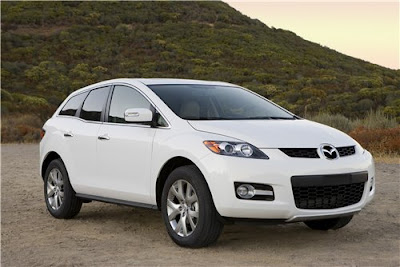
The CX-7 is a mid-size crossover SUV model from Mazda, the production version of the MX-Crossport concept car. The CX-7 is built in Hiroshima, Japan, starting in early 2006. The CX-7 was shown publicly for the first time at the 2006 Los Angeles Auto Show in January. Production officially began on February 20 at Mazda's Ujina#2 factory in Hiroshima. The CX-7 went on sale in spring 2006 as a 2007 model. It is also Mazda's first mid-size SUV since the Navajo was discontinued in 1994. The CX-7 receives an all-new platform instead of sharing the Ford/Mazda CD3 platform used by the larger Mazda CX-9/Ford Edge/Lincoln MKX crossovers as well as the Mazda6. It uses the front suspension of the Mazda MPV minivan, with the rear suspension from the Mazda5. Many of the all wheel drive components come from the Mazdaspeed6. It shares its turbocharged engine with the Mazdaspeed6. It uses a 6-speed automatic transmission. The CX-7 currently slots between the Tribute and the CX-9. Power comes from the same 2.3 L straight-4 MZR engine used in the Mazdaspeed3 and Mazdaspeed6 coupled with a 6 speed Aisin automatic transmission, and tuned to produce 244 hp or 182 kW (Australian model 175 kW) at 5000 RPM and 258 ft·lbf (350 N·m) of torque at a low 2500 rpm, 99% of the maximum torque is available to 5000 rpm. The MZR 2.3L DISI turbo engine found in the Mazdaspeed3 and Mazdaspeed6 has been retuned in the North American-Spec CX-7 to deliver torque at a lower RPM for less turbo lag off the line. This was achieved thanks to a redesigned, smaller KO4 turbocharger. UK-Spec CX-7's feature the same, larger KO4 turbocharger and transmission found in the Mazdaspeed line.

The CX-7 features fully independent suspension, four-wheel ventilated disc brakes with standard anti-lock brakes, stability control and traction control, and a choice of either front wheel drive or Mazda's Active Torque-Split all wheel drive system. With the Active Torque-Split system, two computer-controlled magnetic clutches feed up to 50% of the engine's torque to the rear wheels. The Australian combined cycle official fuel economy is 11.5 L/100 km (24.6 mpg-imp; 20.5 mpg-US). Fuel Economy varies among different tests, owners, and models, but drivers report a typical range between 10.0 L/100 km (28.2 mpg-imp; 23.5 mpg-US) and 18.0 L/100 km (15.7 mpg-imp; 13.1 mpg-US).
As of the 2010 model, there are four trim levels (model):
* iSV is the base version, priced from US$21,550
* iSport is the next version, priced from $24,385
* sTouring is the upscale version, priced from US$26,135
* sGrand Touring is the top version, priced from US$26,935
* Only Touring and Grand Touring models are available with All-Wheel Drive and only these two trims are offered with the 2.3L turbocharged engines while the SV and Sport trims come with a 2.5L MZR naturally-aspirated DOHC four-cylinder.
Canadian models and pricing:
* GS Front-Wheel Drive - $32,095 CDN
* GS All-Wheel Drive - $34,095 CDN
* GT Front-Wheel Drive - $35,295 CDN
* GT All-Wheel Drive - $37,295 CDN
Australian models (AWD only) pricing:
* "CX-7 Classic" Base trim starts at AUD $40,610
* "CX-7 Luxury" Top trim starts at AUD $46,460

This is an update to the original. The exterior design features revised front and rear fascias with the front adopting the larger five-point grille design similar in appearance to the recently redesigned RX-8, MX-5 and Mazda3/Axela. The new interior features redesigned gauges with blackout meters that feature three-dimensional dials, a 3.5 inch super-twisted nematic (STN) monochrome and 4.1-inch thin-film transistor (TFT) colour Multi Information Display (MID), (positioned at the top of the instrument panel), Bluetooth compatibility, and a Blind Spot Monitoring System. The car was unveiled at the 2009 Canadian International Auto Show. The diesel version now includes a manual transmission, and has been on sale in Europe since 2009. Engine choices include 2.5 litre MZR 4-cylinder engine that produces 161 hp (120 kW) and 161 lb·ft (218 N·m) of torque and the same MZR 2.3L DISI Turbo engine from before. Transmission is a 5-speed automatic for the 2.5 and a 6-speed automatic for the 2.3 DISI Turbo engine.The CX-7 reused the name RX-7, (which was a sports car that was discontinued and replaced by RX-8), but the first letter, 'R' ('R' means rotary engine), was changed to 'C' ('C' means crossover SUV).
here are some pictures of Mazda CX-7
 The CX-7 features fully independent suspension, four-wheel ventilated disc brakes with standard anti-lock brakes, stability control and traction control, and a choice of either front wheel drive or Mazda's Active Torque-Split all wheel drive system. With the Active Torque-Split system, two computer-controlled magnetic clutches feed up to 50% of the engine's torque to the rear wheels. The Australian combined cycle official fuel economy is 11.5 L/100 km (24.6 mpg-imp; 20.5 mpg-US). Fuel Economy varies among different tests, owners, and models, but drivers report a typical range between 10.0 L/100 km (28.2 mpg-imp; 23.5 mpg-US) and 18.0 L/100 km (15.7 mpg-imp; 13.1 mpg-US).
The CX-7 features fully independent suspension, four-wheel ventilated disc brakes with standard anti-lock brakes, stability control and traction control, and a choice of either front wheel drive or Mazda's Active Torque-Split all wheel drive system. With the Active Torque-Split system, two computer-controlled magnetic clutches feed up to 50% of the engine's torque to the rear wheels. The Australian combined cycle official fuel economy is 11.5 L/100 km (24.6 mpg-imp; 20.5 mpg-US). Fuel Economy varies among different tests, owners, and models, but drivers report a typical range between 10.0 L/100 km (28.2 mpg-imp; 23.5 mpg-US) and 18.0 L/100 km (15.7 mpg-imp; 13.1 mpg-US).





